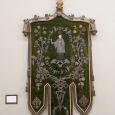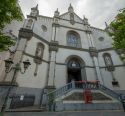Church | 1880 | Neogothic | Catholic Church


Map
Opening hours
01 January - 31 December
Mon 15.00 - 17.00
Tue -
Wed 15.00 - 17.00
Thu -
Fri 15.00 - 17.00
Sat -
Sun -
11 December - 06 January
Mon 15.30 - 17.30
Tue 15.30 - 17.30
Wed 15.30 - 17.30
Thu 15.30 - 17.30
Fri 15.30 - 17.30
Sat 15.30 - 17.30
Sun 15.30 - 17.30
01 April - 21 April
Mon 15.30 - 17.30
Tue -
Wed -
Thu 15.30 - 17.30
Fri 15.30 - 17.30
Sat 15.30 - 17.30
Sun 15.30 - 17.30
26 August - 30 August
Mon 15.00 - 18.00
Tue -
Wed -
Thu 15.00 - 18.00
Fri 15.00 - 18.00
Sat 15.00 - 18.00
Sun 15.00 - 18.00
Religious offices
FR : Sunday 11.30 am
Description
The neo-gothic church was built in 1878-1880 and designed by the architect Charles Demaeght.
The church interior stems from an older period. The stone font dates from 1597 and the two confessionals are early 18th century.
In 1896 the brothers Adrien and Salomon Van Bever (Laken) were asked to build an organ for the new church which they made in the then-favoured romantic style. Each Spring an organ festival is organised. The organ is currently being restored by Jean-Pierre Draps from Kortenberg.
For the jubilee celebrations of the Saint Peter congregation, Robert Van den Haute, Jean-Paul Denis and Guy Paulus published a book: '900 years of christian presence in Jette, 1095-1995'. They especially draw attention to the organ and on following interior church elements:
The tomb of the family de Villegas in the left aisle is in black marble with the coat of arms in white marble. This noble family was the ruler over the county of Saint-Peter, Jette.
The wood carvings are worth a closer look, such as the confessionals with medaillions of St. Hieronymus (left side), St. Gregory the Great (on the right) and St. Peter (above the left altar, with a cockerel on the left).
The procession banners belong to fraternities, lay organisations devoted to spiritual goals. These fraternities existed within the congregation from the 18th to the start of the 20th century.
The main show piece in the church is the statue of the Holy Mary and child in the front on the right, standing at 1.90 meters high.
The font is probably the oldest work of art in the church (1597).
KIKIRPA : Photo-library online
Photos
Media
Remarkable elements
Mausoleum
The Villegas family mausoleum is located in front of the closed door in the left side aisle. The funeral monument was first erected in the chapel of the Annonciade Sisters, rue de Louvain in Brussels. In 1784, the chapel was demolished and the monument transferred to the former church of Jette. During the construction of the neo-Gothic church, the mausoleum was preserved.
The tomb is made of black marble and bears at the top the white marble coat of arms of the noble branch of Villegas, descendants of the Kinschot family, counts of Saint-Pierre in Jette. The whole is elegant and harmonious. The Latin inscription gives the names of the deceased with their titles of nobility: Gaspar de Villegas, who died on 4 December 1785 and his wife Isabella Vanderlaen, who died on 24 September 1783.
Translated with www.DeepL.com/Translator
Organ
In 1896, the church council commissioned the brothers Adrien and Salomon Van Bever to build an organ for the new neo-Gothic St. Peter's Church in Jette. Since 1880 they ran their own company in Laken. The brothers had a great influence on organ building from the end of the 19th century to the beginning of the 20th century. The organ, which was installed in St. Peter's Church in 1898, is one of the most beautiful creations in a romantic style. The organ case is executed in neo-Gothic style.
Confessional
The confessionals date from the 18th century. These are oak furniture from the old church or the abbey church of Dielegem (closed in 1796). On each side, a medallion was placed between the confessionals. They represent a Father of the Church and were made by an unknown master in the second half of the 17th century.
Medallion of Saint Jerome (left). In the 4th - 5th centuries, Jerome translated the Bible from Hebrew into Latin. This translation, the Vulgate, became the official translation of the Church of Rome. Jérôme is surrounded by vine shoots and bunches of grapes as symbols of fertility.
The processional banners
Next to St. Peter's medallion is a banner. Two others are placed on each side of the choir. They belonged to the brotherhoods that existed in the parish from the 18th to the beginning of the 20th century. Brotherhoods are organizations in which lay people come together to serve a divine purpose. The establishment of a brotherhood had to be approved by the Church and was usually dedicated to a particular saint. The brothers helped each other and often also did charitable work.
The banners were carried in procession and come from the chapel of the convent of the Ladies of the Sacred Heart, where the brotherhoods of Jette held their meetings for many years.
Banner of the Blessed Sacrament: near Saint Peter is the oldest banner of the Brotherhood of the Sacrament of the Autaers, probably founded in 1751 at the time of Pastor Alexandre Sigaut. This fraternity consisted of 50 to 100 men who met every month. These bodyguards of the Invisible participated in festive processions and other ceremonies.
Banner of the Brotherhood of St. Francis Xavier: in the choir on the right is the standard of the Brotherhood of St. Francis Xavier, for the conversion of sinners, canonically founded on December 3, 1865.
Banner of the Brotherhood of the Holy Family: the banner on the left probably belonged to the Brotherhood of the Holy Family at the beginning of the 20th century.
Mary, Queen of Heaven
The centrepiece of the church is the statue of the Virgin Mary with the Child Jesus, at the front right of the church. The statue of Mary, 1.90 m high, is that of a woman with the moon under her feet, as described in the book of Revelation of John (12:1-7). As Queen of Heaven, she wears a crown on her head. The statue was restored from 1959 to 1962 by IRPA.
The sculpture bears an AV monogram that refers to the manufacturer, the Malinois sculptor Abraham Van Avont (17th century).
Baptismal font
The baptismal font is probably the oldest work of art in the church. It dates, as is written on the bowl, from 1597. The brass lid, a copper alloy, bears the date 1778. The font stands in the right transept in a hollow in the ground.
When believers enter a sacred space, they want to undergo a kind of purification, a reminder of their baptism. They make a sign of the cross with holy water. That is why there are holy water barrels at the entrance. They stand on either side of the main entrance. The bases are in bluestone in the same style as the columns. At the side entrance, the holy water barrel is built into the wall with the symbols IHS: Jesus our savior.
























